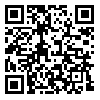Volume 12, Issue 6 (November & December 2021)
BCN 2021, 12(6): 837-848 |
Back to browse issues page
Download citation:
BibTeX | RIS | EndNote | Medlars | ProCite | Reference Manager | RefWorks
Send citation to:



BibTeX | RIS | EndNote | Medlars | ProCite | Reference Manager | RefWorks
Send citation to:
Soltaninejad H, Alizadeh Zarei M, Akbarfahimi M, Azad A, Rabiei F. The Development and Validation of a Scale for the Activities of Daily Living in Iranian Children. BCN 2021; 12 (6) :837-848
URL: http://bcn.iums.ac.ir/article-1-1855-en.html
URL: http://bcn.iums.ac.ir/article-1-1855-en.html
Hossein Soltaninejad1 

 , Mehdi Alizadeh Zarei *2
, Mehdi Alizadeh Zarei *2 

 , Malahat Akbarfahimi2
, Malahat Akbarfahimi2 

 , Akram Azad2
, Akram Azad2 

 , Farzad Rabiei1
, Farzad Rabiei1 




 , Mehdi Alizadeh Zarei *2
, Mehdi Alizadeh Zarei *2 

 , Malahat Akbarfahimi2
, Malahat Akbarfahimi2 

 , Akram Azad2
, Akram Azad2 

 , Farzad Rabiei1
, Farzad Rabiei1 


1- Department of Occupational Therapy, School of Rehabilitation, Iran University of Medical Sciences, Tehran, Iran.
2- Department of Occupational Therapy, Rehabilitation Research Center, School of Rehabilitation, Iran University of Medical Sciences, Tehran, Iran.
2- Department of Occupational Therapy, Rehabilitation Research Center, School of Rehabilitation, Iran University of Medical Sciences, Tehran, Iran.
Abstract:
Introduction: Activities of Daily Living (ADL), as an ultimate goal of rehabilitation, rely on cultural and environmental factors. This study aimed to develop a questionnaire based on the occupational therapy practice frame to accurately evaluate Iranian children’s occupational performance.
Methods: This scale was developed in two phases of planning and construction. The planning phase involved a literature review and a collection of the available evaluation tools in the area. The advice of two expert panels was used to develop a preliminary 87-item questionnaire. In the construction phase, 40 parents were surveyed to assess the popularity of the activities in Iran. After a face to content validation, the final version of the questionnaire was prepared with 93 items.
Results: The final 93-item questionnaire was used to assess the ADL of 3-6-year-old children. The 93 items, selected according to criteria found in the literature and the panel of experts, were categorized into six ranges of occupational therapy practice framework (bathing/washing/personal hygiene, toileting, dressing, eating/feeding, functional mobility, and others).
Conclusion: The ADL in Iranian children is a practical and culturally relevant tool for measuring the occupational performance of Iranian children. It can be used in clinical and population-based research.
Methods: This scale was developed in two phases of planning and construction. The planning phase involved a literature review and a collection of the available evaluation tools in the area. The advice of two expert panels was used to develop a preliminary 87-item questionnaire. In the construction phase, 40 parents were surveyed to assess the popularity of the activities in Iran. After a face to content validation, the final version of the questionnaire was prepared with 93 items.
Results: The final 93-item questionnaire was used to assess the ADL of 3-6-year-old children. The 93 items, selected according to criteria found in the literature and the panel of experts, were categorized into six ranges of occupational therapy practice framework (bathing/washing/personal hygiene, toileting, dressing, eating/feeding, functional mobility, and others).
Conclusion: The ADL in Iranian children is a practical and culturally relevant tool for measuring the occupational performance of Iranian children. It can be used in clinical and population-based research.
Type of Study: Original |
Subject:
Cellular and molecular Neuroscience
Received: 2020/07/10 | Accepted: 2020/10/10 | Published: 2021/11/1
Received: 2020/07/10 | Accepted: 2020/10/10 | Published: 2021/11/1
Send email to the article author
| Rights and permissions | |
 |
This work is licensed under a Creative Commons Attribution-NonCommercial 4.0 International License. |





